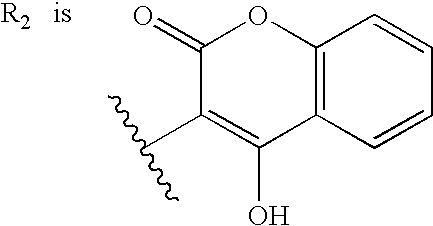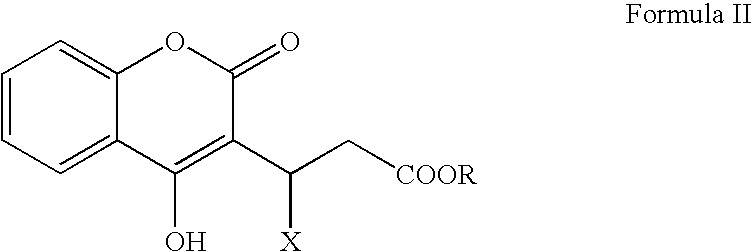Materials and methods for treating coagulation disorders
a technology of coagulation disorders and materials, applied in the field of materials and methods for treating coagulation disorders, can solve the problems of adverse effects, serious and possibly fatal sequelae, shortness of breath, dizziness,
- Summary
- Abstract
- Description
- Claims
- Application Information
AI Technical Summary
Benefits of technology
Problems solved by technology
Method used
Image
Examples
example 1
Preparation of 2-(4-Hydroxy-2-oxo-2H-chromen-3-yl)-butyric acid ethyl ester
[0147]To a solution of 4-hydroxy-chromen-2-one (2.0 g) and ethyl 2-bromobutyrate (2 mL) in DMF was added anhydrous potassium carbonate (8.5 g). The resulting reaction mixture was stirred at room temperature for 72 hours, then diluted with water and extracted with EtOAc. The organic layer was washed with saturated aqueous sodium bicarbonate, dried over MgSO4 and conc. in vacuo to provide colorless oil, which was purified by column chromatography to give 2-(4-Hydroxy-2-oxo-2H-chromen-3-yl) -butyric acid ethyl ester as a white solid, MS: 275[M−H].
example 2
Preparation of 2-Benzyl-3-(4-hydroxy-2-oxo-2H-chromen-3-yl)-propionic acid ethyl ester
[0148]A solution of 4-hydroxy-chromen-2-one (2.0 g), aqueous formaldehyde (37%, 0.37 g), Meldrum's acid (1.77 g) and ammonium acetate (0.95 g) in ethanol (75 mL) was heated to reflux for 6 hours, then cooled to room temperature. The reaction mixture was conc. in vacuo to give the crude as yellow oil, which was purified by column chromatography to provide 3-(4-Hydroxy-2-oxo-2H-chromen-3-yl)-propionic acid ethyl ester as colorless oil (1.2 g).
[0149]To a solution of 3-(4-Hydroxy-2-oxo-2H-chromen-3-yl)-propionic acid ethyl ester in THF at −78° C. was added LDA (1.5M, 3.05 mL) dropwise. A yellow precipitate was formed during the addition. The reaction was stirred at −78° C. for 15 min and allowed to warmed to 0° C. and stirred for 30 min, after which BnBr (0.24 mL in THF) was added dropwise. The reaction was warmed to room temperature, stirred for 12 hours, cooled to 0° C. and quenched with saturated am...
example 3
Preparation of 2-Benzyl-3-(4-hydroxy-2-oxo-2H-chromen-3-yl)-propionic acid
[0150]2-Benzyl-3-(4-hydroxy-2-oxo-2H-chromen-3-yl)-propionic acid ethyl ester (160 mg) in EtOH (1 mL) was added 1N NaOH (1.36 mL). The resulting mixture was heated to 50° C. and stirred for 2 hours, cooled to room temperature, acidified with Conc. HCl / ice and extracted with ether. The organic layer was dried over MgSO4 and conc. in vacuo to give 2-Benzyl-3-(4-hydroxy-2-oxo-2H-chromen-3-yl)-propionic acid as a pale yellow solid (120 mg). MS: 323[M−H].
PUM
| Property | Measurement | Unit |
|---|---|---|
| coagulation time | aaaaa | aaaaa |
| molar ratio | aaaaa | aaaaa |
| enantiomeric excess | aaaaa | aaaaa |
Abstract
Description
Claims
Application Information
 Login to View More
Login to View More - R&D
- Intellectual Property
- Life Sciences
- Materials
- Tech Scout
- Unparalleled Data Quality
- Higher Quality Content
- 60% Fewer Hallucinations
Browse by: Latest US Patents, China's latest patents, Technical Efficacy Thesaurus, Application Domain, Technology Topic, Popular Technical Reports.
© 2025 PatSnap. All rights reserved.Legal|Privacy policy|Modern Slavery Act Transparency Statement|Sitemap|About US| Contact US: help@patsnap.com



